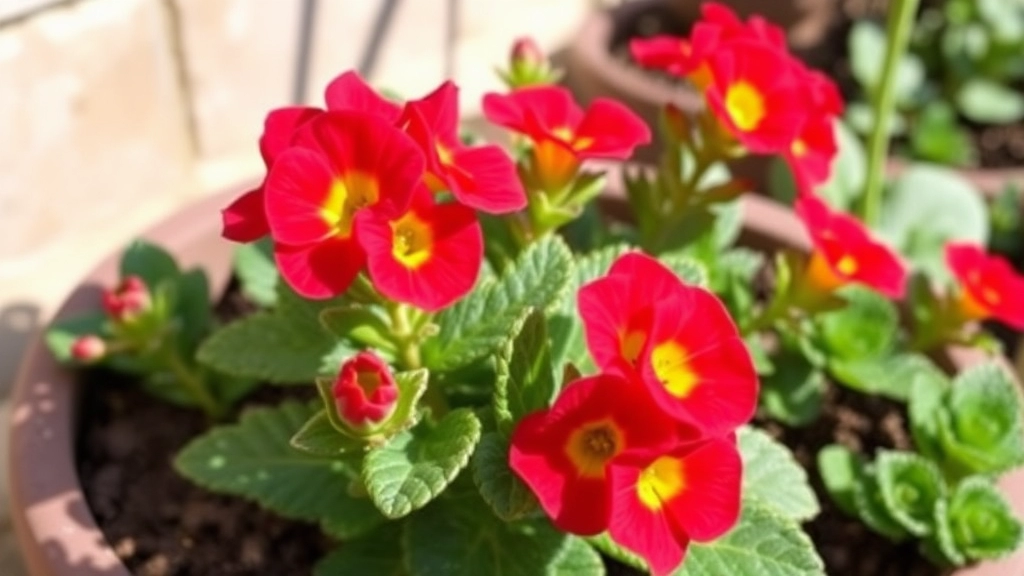Growing Kalanchoe Outdoors
Growing Kalanchoe outdoors can be a rewarding experience if you know the right steps. Whether you’re a seasoned gardener or a beginner, this guide will help you cultivate these vibrant plants in your garden. With the right conditions and care, your Kalanchoe can thrive and add a splash of colour to your outdoor space.
Starting Your Kalanchoe
To start, choose a sunny spot in your garden as Kalanchoe loves sunlight. Ensure the soil is well-draining to prevent root rot. Water moderately, allowing the soil to dry out between waterings. Remember to protect your plants from frost during colder months. With these simple tips, you’ll be well on your way to successfully growing Kalanchoe outdoors.
Selecting the Right Kalanchoe Variety for Outdoor Growth
Are you unsure which Kalanchoe variety suits your outdoor space best?
Choosing the right type of Kalanchoe is crucial for ensuring a thriving garden. With numerous varieties available, understanding their specific needs and characteristics can make all the difference.
Popular Kalanchoe Varieties for Outdoor Growth
- Kalanchoe blossfeldiana
- Known for its vibrant flowers.
- Prefers full sun and well-drained soil.
- Kalanchoe tomentosa
- Features fuzzy leaves and a unique appearance.
- Tolerates drought and thrives in warmer climates.
- Kalanchoe luciae
- Also called “Paddle Plant,” it has striking, flat leaves.
- Requires plenty of sunlight and good airflow.
- Kalanchoe fedtschenkoi
- Recognized for its beautiful blue-green leaves.
- Ideal for hanging baskets or containers.
When selecting a variety, consider the following:
- Sunlight Requirements: Ensure the variety you choose can handle the amount of sun your garden receives. For more details on sunlight needs, check out our guide on optimal sunlight for Kalanchoe.
- Climate Compatibility: Some Kalanchoe types are more resilient in specific climates, so check your local conditions. Learn more about summer care tips for Kalanchoe to ensure your plant thrives.
- Space and Size: Different varieties grow to various sizes, so plan accordingly to avoid overcrowding.
Ideal Climate and Temperature Conditions

So, you’ve picked out your Kalanchoe variety and you’re eager to get it growing outdoors. But wait—what’s the weather like where you live?
Kalanchoes are pretty fussy about their climate.
Temperature
- Ideal Range: They thrive best in temperatures between 20°C to 30°C (68°F to 86°F).
- Cold Sensitivity: If temperatures dip below 10°C (50°F), your Kalanchoe might start to suffer.
Sunlight
- Bright and Direct: These plants love the sun! Aim for at least 6 hours of direct sunlight daily.
- Partial Shade: If you’re in a super hot area, some afternoon shade can help prevent leaf scorch.
Humidity
- Low to Moderate: Kalanchoes prefer a drier environment. High humidity can lead to problems like root rot.
Wind Protection
- Sheltered Spots: If you live in a windy area, consider planting your Kalanchoe in a sheltered location. Strong winds can damage the leaves and stems.
Local Climate Considerations
- Hardiness Zones: Kalanchoes generally do well in USDA zones 10-11. If you’re outside these zones, you’ll need to bring them indoors during colder months.
Preparing the Soil and Planting Location
When it comes to cultivating Kalanchoe outdoors, the right soil and planting location are crucial for success. Many gardeners worry about whether their soil is suitable or if they are planting in the best spot.
Soil Requirements
Kalanchoe thrives in well-draining soil, which is essential to prevent root rot. Here are some key points to consider:
- Soil Type: Use a sandy or loamy mix. A cactus or succulent potting mix is often ideal.
- pH Level: Aim for a slightly acidic to neutral pH, around 6.0 to 7.0.
- Amendments: Incorporate perlite or coarse sand to improve drainage if your soil is heavy or clay-like.
Choosing the Right Location
Selecting the perfect spot for your Kalanchoe can make all the difference. Consider the following:
- Sunlight: Kalanchoe loves bright, indirect sunlight. A location that receives at least 6 hours of light daily is optimal.
- Shelter: Protect your plants from harsh winds and heavy rains, which can damage their delicate leaves.
- Space: Ensure adequate spacing between plants to promote air circulation and reduce the risk of diseases.
Preparing the Planting Area
Before planting, take a few steps to prepare the area:
- Clear the Area: Remove any weeds or debris to reduce competition for nutrients.
- Loosen the Soil: Use a garden fork to aerate the soil, making it easier for roots to establish.
- Test Drainage: Ensure the area drains well by checking if water pools after heavy rain.
For more detailed tips on caring for specific Kalanchoe varieties, check out our Ultimate Guide to Fuzzy Kalanchoe Care and learn about the Top Succulent Kalanchoe Types for Your Garden.
Watering and Fertilizing Your Kalanchoe

After selecting the right Kalanchoe variety and ensuring it’s in a suitable climate, the next crucial step is understanding how to properly water and fertilize your plant.
Watering Your Kalanchoe
One of the most common concerns for Kalanchoe owners is finding the right balance in watering. Too much or too little can lead to problems. Here’s how to get it right:
- Frequency: Water your Kalanchoe every 2-3 weeks during the growing season (spring and summer). In the dormant months (autumn and winter), reduce watering to once a month.
- Soil Check: Always check the top inch of soil. If it feels dry, it’s time to water. If it’s still moist, hold off.
- Watering Technique: Water deeply but infrequently. This encourages deep root growth. Ensure excess water drains away to prevent root rot.
Fertilizing Your Kalanchoe
Fertilization is equally important for promoting healthy growth. Here’s a straightforward approach:
- Type of Fertilizer: Use a balanced, water-soluble fertiliser, preferably one with a ratio of 10-10-10 or 20-20-20.
- Frequency: Fertilize every 4-6 weeks during the growing season. Avoid fertilizing in the dormant months.
- Dilution: Always dilute the fertilizer to half the recommended strength. This prevents nutrient burn.
By following these simple watering and fertilizing tips, you can ensure your Kalanchoe thrives outdoors.
Protecting Kalanchoe from Pests and Diseases
As we delve into the care of your Kalanchoe, it’s vital to consider how to protect these resilient plants from potential threats.
Common Pests and Diseases
Kalanchoe can be susceptible to various pests and diseases. Here are some of the most common:
- Aphids: Tiny insects that suck sap from the leaves, causing them to curl.
- Mealybugs: White, cotton-like pests that can weaken the plant.
- Spider Mites: These can create fine webbing and cause leaf discolouration.
- Fungal Infections: Overwatering can lead to root rot and other fungal issues.
Preventative Measures
Taking proactive steps can save your Kalanchoe from harm. Here’s how:
- Regular Inspections: Check your plants weekly for any signs of pests or disease.
- Good Air Circulation: Ensure plants are spaced adequately to prevent humidity build-up.
- Proper Watering: Water at the base to avoid wetting the leaves, which can lead to fungal issues.
Treatment Options
If you do encounter pests or diseases, don’t fret. Here are effective treatments:
- Neem Oil: A natural pesticide that can deter pests without harming the plant.
- Insecticidal Soap: Effective against soft-bodied insects like aphids and mealybugs.
- Remove Infected Parts: If a leaf is severely affected, prune it away to prevent spread.
Maintaining Plant Health
A healthy Kalanchoe is less likely to fall prey to pests. Follow these tips:
- Fertilise Regularly: Use a balanced fertiliser to ensure your plant is robust.
- Avoid Overcrowding: This reduces competition for resources and improves airflow.
For more detailed care instructions, you can check out our guide on treating black spots on Kalanchoe plants or explore our Kalanchoe species identification guide to understand your plant better.
Pruning and Maintenance for Healthy Growth
So, you’ve got your Kalanchoe thriving outdoors, and now you’re wondering how to keep it looking its best. Pruning and maintenance are key to ensuring your plant remains healthy and vibrant.
Why Pruning Matters
Pruning isn’t just about aesthetics; it promotes healthy growth and helps prevent diseases. Here’s why you should consider it:
- Encourages New Growth: Snipping off dead or wilted leaves allows the plant to focus its energy on new growth.
- Shape and Size Control: Keeping your Kalanchoe in check prevents it from becoming leggy or overgrown.
- Disease Prevention: Removing any diseased or infested parts helps protect the rest of the plant.
When to Prune
Timing is everything! Here’s a quick guide:
- Spring: Ideal for major pruning as the plant comes out of dormancy.
- After Flowering: Once your Kalanchoe has finished blooming, it’s the perfect time to tidy it up.
How to Prune
Let’s break it down:
- Gather Your Tools: You’ll need clean, sharp scissors or pruning shears.
- Identify What to Cut: Look for:
- Dead or yellowing leaves
- Spent flowers
- Overly long stems
- Make Clean Cuts: Cut just above a leaf node to encourage new growth.
Maintenance Tips
Beyond pruning, maintaining your Kalanchoe is essential:
- Watering: Ensure you’re not overwatering. Let the soil dry out between waterings.
- Fertilizing: Use a balanced fertiliser every 4-6 weeks during the growing season.
- Sunlight: Make sure your plant gets plenty of bright, indirect sunlight.
For more detailed care tips, check out our complete guide to Kalanchoe Copper Spoons care and learn how to propagate Kalanchoe from leaves successfully.
FAQs About Growing Kalanchoe Outdoors
What is the ideal temperature range for growing Kalanchoe outdoors?
Kalanchoes thrive best in temperatures between 20°C to 30°C (68°F to 86°F). They are sensitive to cold and can suffer if temperatures dip below 10°C (50°F).
How much sunlight does a Kalanchoe need?
Kalanchoes love the sun and require at least 6 hours of direct sunlight daily. In extremely hot areas, some afternoon shade can help prevent leaf scorch.
Can Kalanchoe tolerate high humidity?
No, Kalanchoes prefer a drier environment with low to moderate humidity. High humidity can lead to problems like root rot.
What should I do if I live in a windy area?
If you live in a windy area, consider planting your Kalanchoe in a sheltered location to protect it from strong winds that can damage the leaves and stems.
In which USDA hardiness zones do Kalanchoes grow best?
Kalanchoes generally do well in USDA zones 10-11. If you live outside these zones, you will need to bring them indoors during colder months.
How often should I water my outdoor Kalanchoe?
Water your Kalanchoe every 2-3 weeks during the growing season (spring and summer). In the dormant months (autumn and winter), reduce watering to once a month. Always check the top inch of soil to determine if it needs watering.
What type of fertilizer should I use for my Kalanchoe?
Use a balanced, water-soluble fertilizer with a ratio of 10-10-10 or 20-20-20. Fertilize every 4-6 weeks during the growing season and avoid fertilizing during the dormant months. Always dilute the fertilizer to half the recommended strength to prevent nutrient burn.
How can I prevent root rot in my Kalanchoe?
To prevent root rot, water your Kalanchoe deeply but infrequently, ensuring excess water drains away. Avoid high humidity and ensure the soil dries out between waterings.
References
-
Kalanchoe Plant Care: Learn About Growing Kalanchoe Plants
-
How to Grow and Care for Kalanchoe
-
Kalanchoe: How to Grow and Care for Kalanchoe
